Cable railway
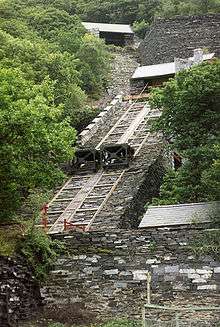
A cable railway (also known as an incline or inclined plane) is a steeply graded railway that uses a cable or rope wound about a cable winch system similar to a ski lift mechanism powered by a stationary engine to haul trains on adversely steep grades. Many such were funicular railroads, where one descending load in part counterbalanced an ascending consist, much like a cable car.
Introduction
Cable railways are typically built where the gradient of the route is so steep that a conventional adhesion train could not climb the track. Most commonly the cable is operated by a stationary engine, although other methods such as gravity or water-balance are also used.
Many cable railways connect to conventional adhesion lines at their top and bottom, allowing trains to be lifted from a lower line to a higher one. A specific type of cable railway is the funicular, which is a cable railway with the cars permanently fixed to the cable.[2] Usually funiculars are self-contained and not connected to other railway networks.
Use
The majority of inclines were used in industrial settings, predominantly in quarries and mines, or to ship bulk goods over a barrier ridgeline as the Allegheny Portage Railroad and the Ashley Planes feeder railway shipped coal from the Pennsylvania Canal/Susquehanna basin via Mountain Top to the Lehigh Canal in the Delaware River Basin. The Welsh slate industry made extensive use of inclines to connect quarry galleries and underground chambers with the mills where slate was processed.[3] The Ashley planes were used to transship heavy cargo over the Lehigh-Susquehanna drainage divide for over a hundred years and became uneconomic only when average locomotive traction engines became heavy and powerful enough that could haul long consists at speed past such obstructions yard to yard faster, even if the more roundabout route added mileage.
Operation

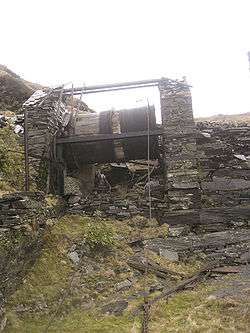
Level tracks are arranged above and below the gradient to allow wagons to be moved onto the incline either singly or in short rakes of two or more.
On the incline itself the tracks may be interlaced to reduce the width of land needed. This requires use of gauntlet track: either a single track of two rails, or a three-rail track where trains share a common rail; at the centre of the incline there will be a passing track to allow the ascending and descending trains to pass each other.
Railway workers attach the cable to the upper wagon, and detach it when it arrives at the other end of the incline. Generally, special-purpose safety couplings are used rather than the ordinary wagon couplings. The cables may be guided between the rails on the incline by a series of rollers so that they do not fall across the rail where they would be damaged by the wheels on the wagons.
Occasionally inclines were used to move locomotives between levels, but these were comparatively rare as it was normally cheaper to provide a separate fleet of locomotives on either side of the incline, or else to work the level sections with horses.
On early railways, cable-worked inclines were also used on some passenger lines, for example the Glasgow Subway until 1935.
Controls
The speed of the wagons was usually controlled by means of a brake that acted on the winding drum at the head of the incline. The incline cable passed round the drum several times to ensure there was sufficient friction for the brake to slow the rotation of the drum – and therefore the wagons – without the cable slipping.[3]
At the head of the incline various devices were employed to ensure that wagons did not start to descend before they were attached to the cable. These ranged from simple lumps of rock wedged behind the wagon's wheels to permanently installed chocks that were mechanically synchronized with the drum braking system. At Maenofferen Quarry a system was installed that raised a short section of the rail at the head of the incline to prevent runaways.[3]
The operation of an incline was typically controlled by the brakesman positioned at the winding house. A variety of systems were used to communicate with workers at the bottom of the incline, whose job it was to attach and detach the wagons from the incline cable. One of the most common communication methods was a simple electrical bell system.[3]
Turnouts
Cable railways were often used within quarries to connect working levels. Sometimes a single cable railway would span multiple levels, allowing wagons to be moved between the furthest levels in a single movement. In order to accommodate intermediate levels, turnouts were used to allow wagons to leave and join the cable railway part way along its length. Various methods were used to achieve this.[1][4]
One arrangement used at the Dinorwic Quarry was known as the "Ballast" method. This involved a two track incline with one track reserved for fully loaded wagons and the second used by partially loaded wagons. The line used by the partially loaded wagons was known as the "ballast" track and it had a stop placed on it part way down. The distance from the top of the incline to the stop was the same as the distance that the fully loaded wagons needed to travel. Empty wagons were hauled up the incline, counterbalanced by the descending ballast wagons. These empty wagons were replaced by fully loaded wagons ready to descend. The descending loaded wagons then returned the ballast wagons to the top of the incline. One of the major inclines at Dinorwic had four parallel tracks, two worked by the ballast method and two as conventional gravity balance.[1]
Types

Cable railways are basically classified by the power source used to wind the cable.
Stationary engine
A stationary engine drives the winding drum that hauls the wagons to the top of the inclined plane and may provide braking for descending loads. Only a single track and cable is required for this type. The stationary engine may be a steam or internal combustion engine, or may be a water wheel.
Gravity balance
In a gravity balance system two parallel tracks are employed with ascending trains on one and descending trains on the adjacent track. A single cable is attached to both trains, wound round a winding drum at the top of the incline to provide braking. The weight of the loaded descending cars is used to lift the ascending empties.[1]
This form of cable railway can only be used to move loads downhill [1] and requires a wider space than a stationary engine -driven incline, but has the advantage of not requiring external power, and therefore costs less to operate.
Tank inclines
A variation of the gravity balance incline was the "tank" incline found at several quarries in north Wales, notably the Dinorwic Quarry. These were worked by gravity, but instead of the wagons running on their own wheels, permanently attached angled wagons were used that had a horizontal platform on which the cargo-carrying wagons rode. Despite their name, these inclines were not a form of water balance incline.[1]
Water balance
This is a variant of the gravity balance incline that can be used to move loads uphill. The weight of the unloaded descending train is increased using water until it is greater than the train travelling uphill. At this point gravity allows the uphill train to ascend. The water is either carried in an additional water wagon attached to the descending train, or is carried in a platform on which the train descends.
This form of incline has the advantages of a gravity balance system with the added ability to haul loads uphill. It is only practical where a large supply of water is available at the top of the incline.
An example of this type of cable railway is the passenger carrying Lynton and Lynmouth Cliff Railway.
Locomotive-hauled
An uncommon form of cable railway uses locomotives, fitted with a winding drum, to power the cable. With the cable or chain attached to the wagons to be drawn, but the drive to the drum disengaged, the locomotive climbs the slope under its own power. When the cable is nearly at its full extent, or when the summit is reached, the locomotive is fastened to the rails and the cable wound in.[5]
In a simpler form the cable is attached to a locomotive, usually at the upper end of the incline. The locomotive is driven away from the head of the incline, hauling wagons up the inclined plane. The locomotive itself does not travel on the steeply graded section. An example is at the Amberley Chalk Pits Museum. This is most commonly used for a temporary incline where setting up the infrastructure of a winding drum and stationary engine is not appropriate. It is similarly employed for recovery operations where derailed rolling stock must be hauled back to the permanent track.[6]
Examples
- 1826 - the Bowes Railway on the outskirts of Gateshead, in England, is the world's only preserved operational 4 ft 8 1⁄2 in (1,435 mm) (standard gauge) cable railway system.
- Cromford and High Peak Railway opened in 1831 with grades up to 1 in 8. There were nine inclined planes: eight were engine-powered, one was a counterbalance (gravity) type operated by a horse gin. The Middleton Top winding engine house at the summit of Middleton Incline has been preserved and the ancient steam engine inside, once used to haul wagons up, is often demonstrated.
- Liverpool and Manchester Railway
- Opened with cable haulage down a 1 in 48 grade to the dockside at Liverpool.
- Designed for cable haulage up and down 1 in 100 grades at Rainhill in the belief that locomotive haulage was impracticable. The Rainhill Trials showed that locomotives could handle 1 in 100 gradients.
- Brampton Railway was reconfigured in 1836, and included a gravity balanced inclined plane between Kirkhouse and Hallbankgate. It had a maximum gradient of 1 in 17. The mineral lines above the plane were operated after 1840 by Stephenson's Rocket.
- High Peak Junction opened 29 May 1830 with railway incline connecting two canals.
- A Pit fishbelly gravitational railway operated between 1831 and 1846 to service the Australian Agricultural Company coal mine. B Pit opened 1837 and C Pit opened mid-1842. All were private-operations by the same company.
- 1837, July 20 - Camden Incline, Between Euston and Primrose Hill on the London and Birmingham Railway.[7]
- The Welsh slate industry made heavy use of gravity balance and water balance inclines to move slates from quarries down to transshipment points. Examples of substantial inclines were found in the quarries feeding the Ffestiniog Railway, the Talyllyn Railway and the Corris Railway amongst others.
- The Denniston Incline (1879–1967), north of Brunner, New Zealand, was gravity worked. It descended 518 m (1,699 ft) in a track distance of 1,670 m (5,479 ft), separated into two inclines, and during its life carried 13,000,000 t (12,794,685 long tons; 14,330,047 short tons) of coal.[8]
- The middle section of the Erkrath-Hochdahl Railway in Germany (1841–1926) had an inclined plane where trains were assisted by rope from a stationary engine and later a bank engine running on a second track. The height difference was 82 metres over a 2.5 kilometre length[9] (1845–1926)
- 1832 - 1 in 17 Swanington incline on Leicester to Burton upon Trent Line, later deviated in 1848.
- 1832 - 1 in 29 Bagworth incline on Leicester to Burton upon Trent Line, later deviated in 1871.
- The Yosemite Valley Railroad operated a cable railway at Incline, California.
- A canal inclined plane lift was created during the late 18th century at Blists Hill Victorian Town in Shropshire, England.
- The Duquesne Incline in Pittsburgh, PA was completed in 1877, and is 800 feet (240 m) long and 400 feet (120 m) high.
- 1870 - The Monongahela Incline, also in Pittsburgh, PA, and is 635 feet (194 m) long, and 369 feet (112.59 m) high.
- 1891 - The Johnstown Inclined Plane, in Johnstown, PA, was completed following the Great Johnstown Flood of 1889. Dubbed the "World's Steepest Vehicular Inclined Plane", it is 896.5 feet (273.3 m) long, and ascends 502.2 feet (153.1 m) from the city valley to Westmont hilltop at a 70.9 percent grade.
- 1861 - São Paulo Railway, Brazil
-

Katoomba Scenic Railway.
originally hauled coal. -

The 52° acute angle track
-
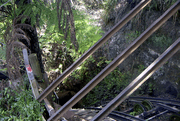
Katoomba Scenic Railway descending to the valley floor
-
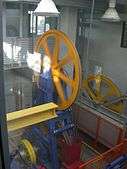
Scenic Skyway Mechanism
-
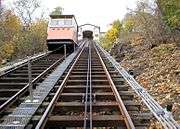
Monongahela Incline ascending Mt Washington in Pittsburgh, PA
See also
References
- 1 2 3 4 5 6 Carrington D.C. and Rushworth T.F. (1972). Slates to Velinheli: The Railways and Tramways of Dinorwic Slate Quarries, Llanberis and the Llanberis Lake Railway. Maid Marian Locomotive Fund.
- ↑ Walter Hefti: Schienenseilbahnen in aller Welt. Schiefe Seilebenen, Standseilbahnen, Kabelbahnen. Birkhäuser, Basel 1975, ISBN 3-7643-0726-9 (German)
- 1 2 3 4 Boyd, James I.C. On the Welsh Narrow Gauge. Bradford Barton.
- ↑ Boyd, James I.C. (2001). Narrow Gauge Railways in North Caernarvonshire: Volume Three: The Dinorwic Quarry and Railways, The Great Orme Tramway and other rail systems (Second ed.). The Oakwood Press.
- ↑ Bianculli, Anthony J. (2001). Trains and technology: the American railroad in the nineteenth century. Cranbury, NJ: University of Delaware Press. p. 131. ISBN 0-87413-729-2.
- ↑ Picture of recovery gear that uses a locomotive as its power source(Accessed 2008-03-26)
- ↑ "Listed building details: Camden Incline Winding Engine House". London Borough of Camden. Retrieved 17 December 2010.
- ↑ Denniston Incline (including video) (Access date: 18 June 2007)
- ↑ with a gradient of 1 in 30 (3.3%). German Wikipedia Article (in German!)
